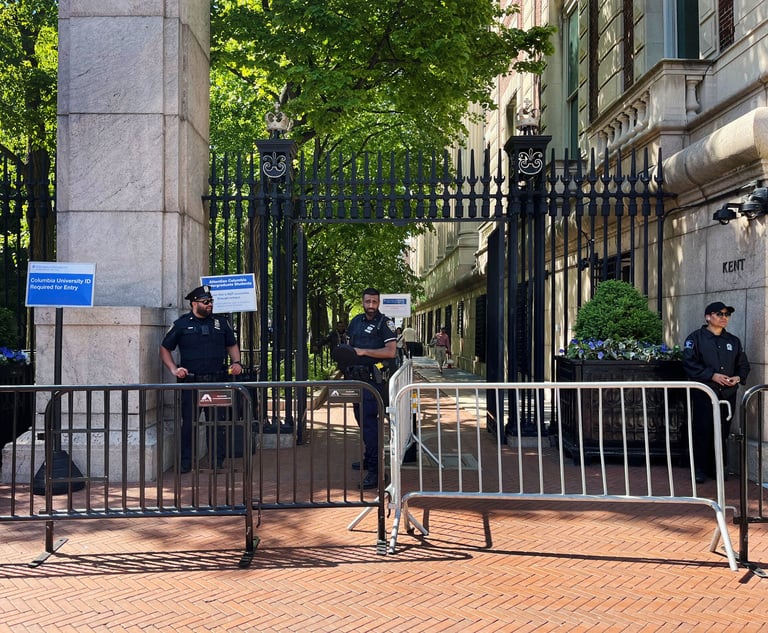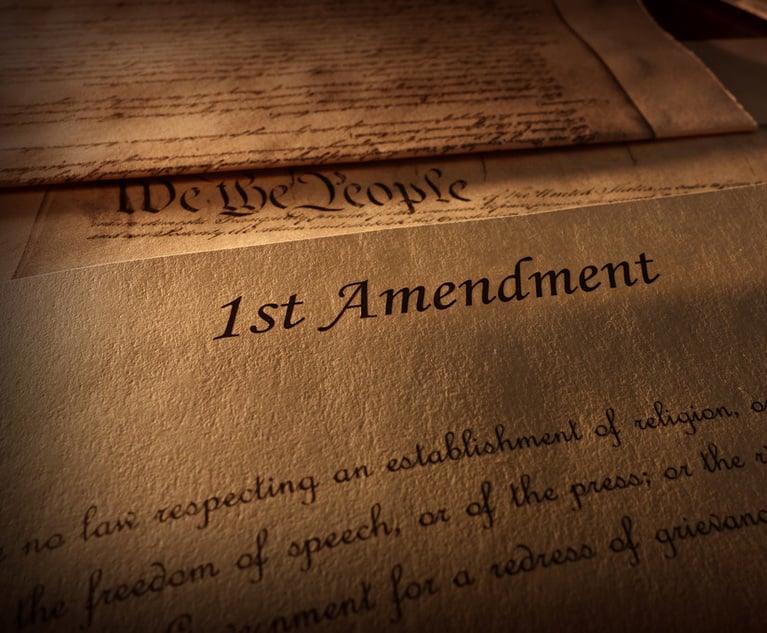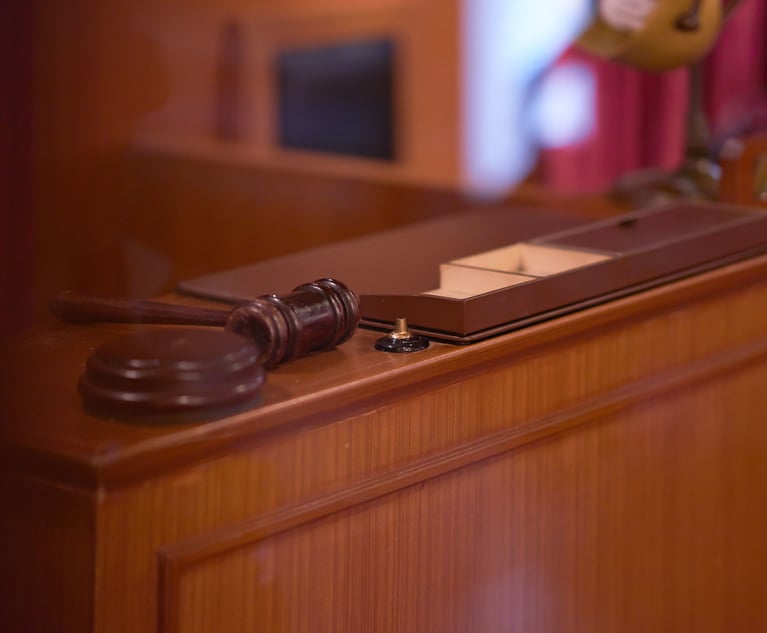Ahead of the Curve: Pod Save the Lecture. Plus, Law School Gets Way Cheaper (It's True!)
Saint Louis University Law Professor Marcia McCormick has a few thoughts about incorporating technology into the law classroom, and the University of Kansas is about to give out-of-state law students a big tuition break.
December 10, 2018 at 09:00 PM
9 minute read
Welcome back to Ahead of the Curve. I'm Karen Sloan, legal education editor at Law.com, and I'll be your host for this weekly look at innovation and notable developments in legal education.
This week, I'm chatting with Saint Louis University Law Professor Marcia McCormick about how to incorporate technology into the law classroom, and how well (or not) the academy is doing on that front. Next up is a look at how SUNY Buffalo Law is branching into undergraduate education. Finally, I check in with the University of Kansas, which about to give out-of-state law students a big tuition break.
Please share your thoughts and feedback with me at [email protected] or on Twitter: @KarenSloanNLJ
➤➤ Would you like to receive Ahead of the Curve as an email? Sign up here.
A Call to Action—For Tech in the Classroom
We all know the stereotype of a law class. A Professor Kingsfield-type stands at a lectern, droning on while students live in dread of being cold called. So is that really the best way to teach law? And is that even what happens in today's law classrooms?
To probe at those questions, I rang up Marcia McCormick, a professor at Saint Louis University School of Law whose recent article on harnessing technologycaught my eye. McCormick's article talks about how she provides podcasts to reinforce her lecture lessons and uses online quizzes to help students apply the law and become accustomed to the way law school exam questions work.I wanted to know more about her specific techniques, but also how she thinks the legal academy is doing as a whole at embracing technology in the classroom.
Let me take up the second question first. It's a mixed bag out there, according to McCormick. Perhaps the most mainstream experiment in the legal academy is the so-called “flipped classroom,” where professors record lectures or present them on power point or other programs before class then use class time exclusively for discussions, analysis, application or projects. But despite a fair bit of discussion and interest in the flipped classroom model, relatively few professors use it on an ongoing basis, McCormick told me. And other professors, McCormick included, are using different technology in classroom, but they are in the minority.
McCormick said she doesn't know of many other professors producing class-based podcasts like hers, though her project is the outgrowth of an earlier push by the Center for Computer-Assisted Legal Instruction (better known as CALI) to have law professors record their lectures. For each class, McCormick produces a podcast of about 20 minutes covering the main points of her lecture. (She also makes the podcast script available for students who prefer to read rather than listen.) Here are the benefits:
➤➤ Students get an easily digestible overview of the lesson
➤➤ They can listen to the podcast when it's convenient for them, be it while driving in to school or walking the dog
➤➤ Writing out the podcast gives McCormick the chance to hone her lesson plan.
Now, McCormick said she expects some in the legal academy to be skeptical of this method. “I think some professors might hesitate to do the kind of podcast I do because they think it's too much spoon-feeding,” she told me. “Pedagogically, they might disagree with [podcasts]. I started as a legal writing professor, and the one lesson I learned is that it is not possible to make things too easy—students still have to do the hard work to understand, even if they're given a rule. I have not found that it has not been a crutch for my students. Mostly they are grateful.”
But she acknowledged that the time it takes to produce a good post-class podcast is a drawback. She typically spends about eight hours on each one, between mapping out topics, writing a script, and recording it. The online quizzes she uses are less time-intensive, typically taking about two hours to put together.
And online quizzes are easier to offer than ever for legal academics, given that textbook publishers have begun developing their own assessment products. (The development was precipitated by the American Bar Association adding student learning outcomes to its standard, meaning schools have to state what they aim to teach law students and how well they are doing at meeting that goal.)
My thoughts: I don't think every law professor should rush out and start recording podcasts or create online quizzes, and McCormick doesn't either. Her article is more of a wider call to legal academics to experiment with their teaching methods and figure out how to use tech in the classroom. (In case you missed last week's newsletter looking at Gen Z law students, the Cliffs Notes version is that they are accustomed to technology in nearly every aspect of their lives.) McCormick sums it up nicely:
“There are so many tools and technology out there that people are experimenting with. They are experimenting with Twitter in the classroom; with various ways to use clickers; with drafting together on a Google document. All kinds of things. I think the biggest hurdle is feeling like it has to be perfect the first time you use it. It doesn't. Trial and error is OK.”
Hello, Undergrads!
The State University of New York at Buffalo Law School is branching out into undergraduate education, with the university's first-ever minor in law. The minor launched this fall, with law faculty teaching a variety of law courses for undergrads, including Introduction to the American Legal System, Sports Law and Federal Law.
Buffalo isn't the first law school to expand into undergraduate education.Recall the University of Arizona James E. Rogers College of Law in 2014 launched a Bachelor of Arts in Law—a first-of-its-kind that differs from the more general pre-law major in that it closely resembles the law school curriculum and is taught by law professors. And I've heard of plenty of law schools farming out faculty to teach undergraduate courses in recent years as enrollments drooped and some professors found themselves with some spare time.
Buffalo hopes to begin offering an undergraduate major in 2019, and is awaiting approval from the ABA and state university officials. There is apparently demand on campus. More than 70 undergrads signed up for this semester's Introduction to the American Legal System. Here's law professor James Gardner, who is teaching that class:
“The students have been enthusiastic and engaged. Many of the students in the class are already interested in a career in law, and many others are intrigued by and open to the idea.”
The takeaway: Gardner's comment nails why I think this is a smart move. It gets law school on the radar of the undergraduates whom you hope to eventually bring in. Sure, some will take a class or two and decide law is boring, but others will discover they're really into it and may go on to apply to law school when they wouldn't have otherwise.
A $10,000 Discount? Yes, Please!
Good news out of Kansas: Nonresident students at the Sunflower state's flagship law school will soon pay about $10,000 less per year. That's a big chunk off the $38,726 current list price for nonresident students and will bring the annual cost with about $7,000 of the lower price resident students pay.
So why the big price drop? Kansas Law is clearly hoping to recruit a larger number of high-credentialed applicants from out of state. (Kansas is a strong school, but has slipped nine spots in the most recent U.S. News & World Report rankings to land at No. 74.)
Reducing the price will hopefully get more non-residents interested in the school, while also freeing up more scholarship money to direct to Kansans, according to this story on the university's website. Law Dean Steven Mazza said the adjustment to out-of-state tuition will bring the law school more in line with peer schools, while also emphasizing that the in-state tuition of $22,562 is relatively low. The Kansas Board of Regents has signed off on the plan to reduce non-resident tuition, but the school has yet to iron out the exact cost for the upcoming school year.
Extra Credit Reading
—➤ The University of Michigan has landed a $33 million donation from alumni real estate developer Chris Jeffries. It plans to use the money for scholarships.
—➤ Columbia Law School's Human Rights Clinic is partnering with the Clooney Foundation for Justice—as in George and Amal Clooney—to launch TrialWatch, a program where volunteers will monitor trials around the globe for human rights violations.
—➤ High profile law professor Ian Samuel, who helped spur the law student movement against mandatory arbitration in Big Law by disclosing one such agreement on Twitter, is being investigated by Indiana University for potential Title IX violations.
—➤ Meanwhile, here is a look at other law professors to come under the microscope amid the #MeToo movement. And women's groups at top law schools are joining together to fight mandatory arbitration in Big Law.
Thanks for reading Ahead of the Curve. Sign up for the newsletter and check out past issues here.
I'll be back next week with more news and updates on the future of legal education. Until then, keep in touch at [email protected]
This content has been archived. It is available through our partners, LexisNexis® and Bloomberg Law.
To view this content, please continue to their sites.
Not a Lexis Subscriber?
Subscribe Now
Not a Bloomberg Law Subscriber?
Subscribe Now
NOT FOR REPRINT
© 2025 ALM Global, LLC, All Rights Reserved. Request academic re-use from www.copyright.com. All other uses, submit a request to [email protected]. For more information visit Asset & Logo Licensing.
You Might Like
View All



Trending Stories
Who Got The Work
J. Brugh Lower of Gibbons has entered an appearance for industrial equipment supplier Devco Corporation in a pending trademark infringement lawsuit. The suit, accusing the defendant of selling knock-off Graco products, was filed Dec. 18 in New Jersey District Court by Rivkin Radler on behalf of Graco Inc. and Graco Minnesota. The case, assigned to U.S. District Judge Zahid N. Quraishi, is 3:24-cv-11294, Graco Inc. et al v. Devco Corporation.
Who Got The Work
Rebecca Maller-Stein and Kent A. Yalowitz of Arnold & Porter Kaye Scholer have entered their appearances for Hanaco Venture Capital and its executives, Lior Prosor and David Frankel, in a pending securities lawsuit. The action, filed on Dec. 24 in New York Southern District Court by Zell, Aron & Co. on behalf of Goldeneye Advisors, accuses the defendants of negligently and fraudulently managing the plaintiff's $1 million investment. The case, assigned to U.S. District Judge Vernon S. Broderick, is 1:24-cv-09918, Goldeneye Advisors, LLC v. Hanaco Venture Capital, Ltd. et al.
Who Got The Work
Attorneys from A&O Shearman has stepped in as defense counsel for Toronto-Dominion Bank and other defendants in a pending securities class action. The suit, filed Dec. 11 in New York Southern District Court by Bleichmar Fonti & Auld, accuses the defendants of concealing the bank's 'pervasive' deficiencies in regards to its compliance with the Bank Secrecy Act and the quality of its anti-money laundering controls. The case, assigned to U.S. District Judge Arun Subramanian, is 1:24-cv-09445, Gonzalez v. The Toronto-Dominion Bank et al.
Who Got The Work
Crown Castle International, a Pennsylvania company providing shared communications infrastructure, has turned to Luke D. Wolf of Gordon Rees Scully Mansukhani to fend off a pending breach-of-contract lawsuit. The court action, filed Nov. 25 in Michigan Eastern District Court by Hooper Hathaway PC on behalf of The Town Residences LLC, accuses Crown Castle of failing to transfer approximately $30,000 in utility payments from T-Mobile in breach of a roof-top lease and assignment agreement. The case, assigned to U.S. District Judge Susan K. Declercq, is 2:24-cv-13131, The Town Residences LLC v. T-Mobile US, Inc. et al.
Who Got The Work
Wilfred P. Coronato and Daniel M. Schwartz of McCarter & English have stepped in as defense counsel to Electrolux Home Products Inc. in a pending product liability lawsuit. The court action, filed Nov. 26 in New York Eastern District Court by Poulos Lopiccolo PC and Nagel Rice LLP on behalf of David Stern, alleges that the defendant's refrigerators’ drawers and shelving repeatedly break and fall apart within months after purchase. The case, assigned to U.S. District Judge Joan M. Azrack, is 2:24-cv-08204, Stern v. Electrolux Home Products, Inc.
Featured Firms
Law Offices of Gary Martin Hays & Associates, P.C.
(470) 294-1674
Law Offices of Mark E. Salomone
(857) 444-6468
Smith & Hassler
(713) 739-1250










